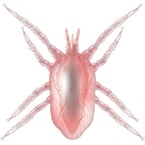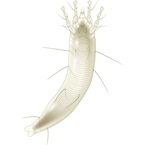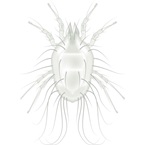Species category: Mites
Latin Name: Dermanyssus gallinae
Family: Dermanussidae
What is a Red Poultry Mite?
Red Poultry Mite Description
The Red Poultry Mite is usually less than 2mm long in adulthood. It appears colourless or white turning to a bright red or grey-black colour when fully engorged with blood, the body becomes darker as the blood is digested.
Oval in shape, the adults have 8 legs and use the front pair as sensory organs.
A cosmopolitan species, widely distributed throughout Europe and most of the Northern Hemisphere, they are also found in many other parts of the world.
These mites are usually located in wild birds’ nests, and feed on the blood of birds such as pigeons, starlings, sparrows, swallows and house martins.
Red Poultry Mite Behaviour
These mites are a nocturnal species, spending the day resting in cracks and crevices where they are safe from the birds. At night, they attack the birds and feed for up to 2 hours.
They thrive in high humidity and struggle in extreme temperatures e.g. >45°C and - 20°C are lethal and survival is not expected.
Eggs are laid in the cracks around nests and roost sites. The lifecycle is fast, typically taking a week, and in order to complete the lifecycle both nymphs and adults require blood meals.
When the birds leave their nests, the mites disperse and infest nearby buildings including poultry units. Mites can be introduced into poultry farms from a wild bird’s infestation or with newly introduced poultry, on equipment, transport or clothing.
Risks associated with Red Poultry Mite
A scourge of poultry farms, conditions in poultry houses are ideal for these mites and large populations can rapidly develop.
Its bites are painful, irritating and can cause lethargy. Poultry also suffer decreased egg production and in extreme cases, death, as a result of anaemia.
The Red Poultry Mite is a transmitter of a number of poultry diseases including Salmonella and Newcastle virus. Adult mites are resistant to desiccation and starvation. They can survive without food for several months.



